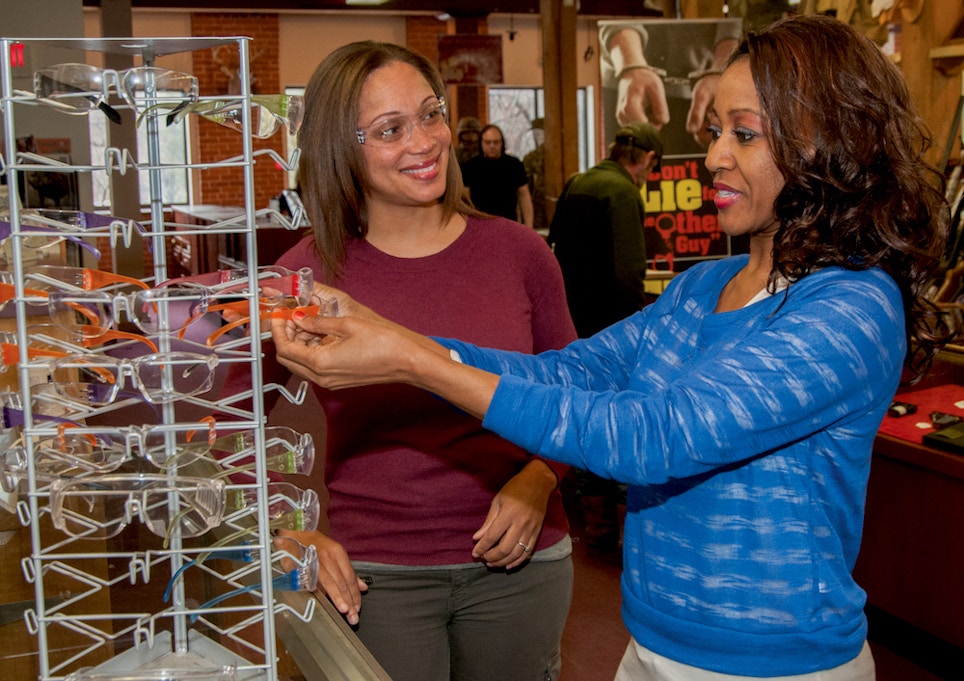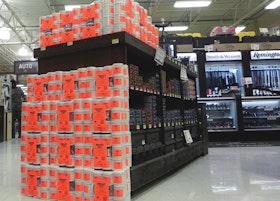You’ve probably seen it before. A guy comes into your shop, looks around for a little while, then begins to look frustrated. You ask if you can help him find something. He replies, “No, just looking,” and walks out.
It’s likely you just missed making a sale because the guy couldn’t find what he was looking for and, for whatever reason, didn’t want to ask where the scope rings, rifle slings or pistol grips were. Maybe he’s just shy. Perhaps he only had a few minutes and feared getting into a long, drawn out conversation.
For retailers, selling products is the name of the game, and selling products with a high profit margin is even more critical to success. Doing so, however, isn’t always a simple task.
Understanding and better utilizing end caps can be one strategy to immediately increase sales and bolster your bottom line. These prime pieces of real estate are sometimes overlooked by retailers, and even those who don’t overlook end caps sometimes underutilize them.
Defining the Space
In a nutshell, end caps are displays found at the end of aisles that customers see when they go looking for other products found in the aisle on either side. Typically, they include products related to what the customer would be looking for on the adjacent aisles. Most retail experts agree that end caps can be among the most valuable and productive sales spaces in your store.
A friend of mine from high school, Jeff, has 36 years experience in retail, with most of it as management in big-box stores. In his lengthy career, he has designed literally thousands of sporting goods end caps. Watching those end caps succeed or fail has given him valuable insight into strategies that can benefit anyone in the retail business.
To Jeff, one of the most important things about end caps relates to the actual design and building of the displays.
“One thing people need to know is in the actual building of the display, whether it’s shotgun shells or whatever the item is, you need to make sure there’s no peg board showing between the items,” he says. “Basically, all the space should be utilized so that, number one, it looks good; and number two, you get the maximum use of that important space.
“A saying that we’ve always used is, ‘You don’t sell pegboard.’ If you see the pegboard, then there’s no merchandise there. It needs to be filled in with merchandise.”
In order for that to happen, of course, the retail establishment needs to have someone monitoring end caps quite frequently, and that’s not always easy, depending on staffing. Plus, some types of products have to be replenished more often than others.
“Frequency depends on what the item is,” explains Jeff. “If the end cap is large — 8 to 9 feet tall and 3 to 4 feet wide — it has a lot of holding power. So, for instance, you can get a lot of individual boxes of shells on one of those versus if you’re stocking larger items like coolers. With those, you’d have to have someone fill it on a more regular basis.
“If it’s a guy who has just two or three employees in his store, it’s going to be harder for him to keep up with it than if it’s an Academy, or Walmart or Dick’s Sporting goods or a company like that with a hundred or more employees in the store.”
The Right Height
Another consideration during the design and construction phase is putting products at the proper height for maximum visibility. Fact is, visibility is directly related to sales. While many retailers overlook this aspect of end caps, Jeff believes it is critical to maximizing profit.
“Try to set everything where it’s no higher than 5 feet, because the average woman is 5’ 4” and average man is 5’ 9”, is what they say,” he says. “So, if you set it at 5 feet, which is just like someone looking straight ahead or down a little bit, that’s where most people look when they look for merchandise. They don’t look up; they don’t look down. They look straight ahead and down a little bit.
“So put the items you want to sell the most of (generally, higher profit margin items) at that height.”
Keep the Theme
Still another important aspect is determining what products should go on the end cap and what products should not. It’s not an exact science, but there are some guidelines you can follow.
“One thing that is important is, say you’re going into an aisle that has archery accessories, for instance,” Jeff says. “You want to have items on the two end caps that are going into that aisle — left and right — related to what’s in that aisle. You don’t want blackpowder stuff out there going into an archery aisle. You want to try to keep the theme on the end cap that fits what’s in the aisle it is going into.
“That way, if you are sold out of the item in either place, the customer can quickly find it and say, ‘Oh, it’s right here.’”
Make it Easy
Concerning the ease of finding merchandise, few things are more irritating to repeat shoppers than going to where they regularly find a repeat-purchase product, only to not be able to locate it. After giving up, they find what they were looking for on a nearby end cap that they didn’t see because they were focused on the usual spot.
“That’s something they preach in retail — don’t forsake your side counter for an end cap,” Jeff said. “If you don’t have enough product to support your side counter where customers normally go to buy shotgun shells or scope rings or whatever you’re putting out there, don’t put it on the end cap. Either order more or choose something else for the end cap. Because you’re going to kill your regular customers who come in there and might not even see the end cap when they go to that aisle where they normally buy it.”
Another frequent customer frustration is to find what they are looking for on an end cap, only to have to go to the original spot where that product usually resides to learn the price. Sending customers on a search is never a good practice.
“There should be a shelf label on the shelf or peg where the item is,” explains Jeff. “And if it’s a smaller shop that marks everything with a marking gun, every item should be marked where customers can see it.
“And if it’s on sale, you should have sale flags hanging out there where people know that. Number one, it’s going to sell more if they have the sale price showing. Number two, that’s just how it’s supposed to be done.”
In fact, Jeff says sales items are frequently chosen for end caps, and for good reason.
“You sell more of it if it is out front,” he says. “And customers are better able to find it that way — especially if it’s something that you don’t normally sell a lot of at regular price.”
Display Life
The topic of how long to leave an end cap to determine whether it will be productive or not is often cussed and discussed among retail managers. In Jeff’s opinion, you can’t leave a non-productive end cap in place long at all. And price is a major consideration in determining end cap longevity.
“If priced right, you can sell a lot of products on your end cap,” he says. “If it’s not priced right, you’re wasting your time putting it there. If it doesn’t sell within a few days, then you might as well change it for something else or lower the price — one of the two.
“You can’t leave it there too long because that’s prime real estate. You’ve got to put something there that will sell.”
For general sporting goods sales, much of end cap design and product selection is seasonal. In Oklahoma where Jeff has spent his career, when fall arrives, most end caps revolve around the upcoming hunting seasons.
“Seasonality is definitely a huge factor in a sporting goods store, and you have to pay attention to it,” he says. “You know, you don’t want to put deer scents or anything like that out during the spring, when seasons are in the fall.
“Around dove season, obviously you’re going to want to have shotgun shells, dove buckets and traditional camo gear out there. If it’s turkey season you’re probably going to have a turkey shotshell load or ghillie suit or that kind of thing. Put what they need for that season out there so they can buy everything in one spot without having to walk all around the store to get it.”
Obviously, timing is critical for seasonally themed end caps. The relative popularity of the season generally dictates how early you build the end cap to cater to sportsmen shopping for that season.
“We usually set up end caps about a month before a short season like turkey season,” Jeff says. “For deer, it might be a month or month and a half. For dove, it could even be two months out. That’s a pretty big season, in Oklahoma especially.”
Cap Promotions
For retailers specializing more in tactical guns and gear, hunting seasons can still drive some traffic. But sometimes those retailers have to create their own “seasons,” then stock their end caps accordingly.
“Just have a promotion,” Jeff suggests. “If it’s a local store that does an ad or insert in the local newspaper, they could say, ‘It’s MSR month at Joe’s Sporting Goods Store. All of our whatever they’re selling — swivels, slings — are 20% off this week.’ Then they stock their end caps accordingly. They’ll still be making money on it because that kind of stuff has a good markup.”
Another example would be a gun shop creating a monthly emphasis to highlight certain products it would then stock in its end caps. For instance, a store could declare June to be “Safety Month,” then stock end caps with hearing protection, eye protection and other safety-related gear — most of which have high profit margins.
While Jeff’s insights are important, other suggestions for end cap strategies are also worthy of consideration. Some of these include adding technology to end caps (like televisions playing videos), asking yourself what you would want to see on an end cap if you were the customer, taking full advantage of a banner at the top of the end cap, highlighting new products with cross merchandising and steering shoppers to aisles where high-margin products are available for purchase.
In the end, creating good-looking, profitable end caps is just as much art as it is science. Becoming successful at selling through these important pieces of retail space takes some time, effort and even trial and error. Don’t give up, as end caps represent profit potential that you don’t want to miss.








